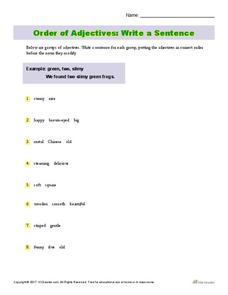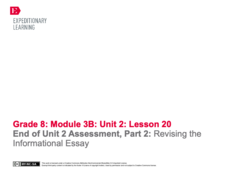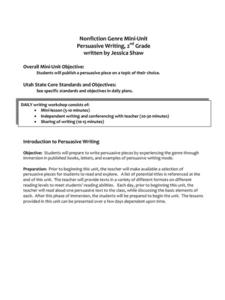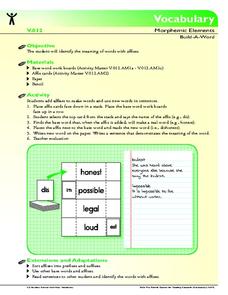McGraw Hill
Writing Prompts, Student Rubrics, and Sample Responses
Whether you are teaching mainstream, advanced, or intervention language arts classes, you will find something helpful in a thorough writing packet. It includes prompts, rubrics, responses, helpful hints, graphic organizers, and many...
K12 Reader
Order of Adjectives: Write a Sentence
Knowing the parts of speech can make you a better writer! Young grammarians use sets of two and three adjectives to write engaging sentences, taking care to use the adjectives in the correct order.
EngageNY
Writing: Drafting Body Paragraphs and Revising for Language
Begin the drafting phase of the writing process with a lesson plan focused on logically writing three body paragraphs. Then, revise the writing to make it more formal after a teacher-directed mini-lesson plan. Each paragraph highlights...
EngageNY
End of Unit 2 Assessment, Part 2: Revising the Informational Essay
Writers look at the End of Unit 2 Assessment: Best First Draft of an Informational Essay handout and use sticky notes to identify things in their work that need editing and revising. They reference their notes to finalize their...
Curated OER
Nonfiction Genre Mini-Unit: Persuasive Writing
Should primary graders have their own computers? Should animals be kept in captivity? Young writers learn how to develop and support a claim in this short unit on persuasive writing.
Florida Center for Reading Research
Phonics: Onset and Rime, Word Swat
With a fly swatter in hand, learners swat the rime-flys with their onset swatter to make, read, and write words by blending the onset with the rime-fly. Scholars blend words, make and write words, and also work to determine if the words...
EngageNY
Revising for Organization and Style: Bold Beginnings
Get young writers thinking about how to write a great beginning for their narratives. After examining examples of solid beginnings in literary text, young writers discuss the criteria for a compelling introduction. Then, independently,...
EngageNY
Peer Critique and Revision: Storyboard, Sections 1-4
Teamwork makes the dream work. Pupils participate in a peer critique process, using forms to offer constructive advice about each other's storyboards. Next, scholars revise their storyboards based on the feedback, and then share their...
EngageNY
Group Discussions and Revision: Editorial Essay
Great minds think aloud! Pupils participate in the Fishbowl protocol, discussing their opinions about the Mary River mine proposal. As they share their thoughts, peers provide feedback about their thesis and supporting ideas.
EngageNY
Peer Critique: Historical Accuracy of Ideas and Vocabulary
Promote collaboration in the classroom with a historical fiction instructional activity. Fourth graders partner up and read the other's narrative to give feedback on vocabulary choice and the accuracy of historical information. After...
Teaching Oasis
Gingerbread Baby Lesson Plan Guide
Reinforce reading comprehension and story mapping skills with the help from a story, Gingerbread Baby by Jen Brett. Individuals discover new vocabulary, make predictions, retell main events, respond to reading using a graphic...
Federal Reserve Bank
“Dewey Defeats Truman”: Be Aware of Data Revisions
Discover the impact and importance of data releases about current economic conditions in the United States. Your class members will learn about data revision and the GDP, and how these figures can alter people's views on the economy.
Jessica Winston
Gingerbread Friends Lesson Plan Guide
Full of activities for Jan Brett's story "Gingerbread Friends," this resource will get your kids in the mood for some snacks, fortify their need for vocabulary, and fill their minds with story elements.
Reed Novel Studies
The Indian In The Cupboard: Novel Study
Don't judge a book—or a toy—by its cover. Omri, a main character in The Indian in the Cupboard, quickly judged his plastic toy figures as boring. However, once placed in the cupboard, Omri's toys became something he never imagined....
Reed Novel Studies
The Wind In The Willows: Novel Study
True friends stick together. In the case of The Wind In The Willows, the friends just happen to be a toad, mole, rat, and badger who team up to beat the weasels. The resource covers the first chapter of their raucous adventures. Scholars...
Reed Novel Studies
There's a Boy In The Girls' Bathroom: Novel Study
People travel to Washington, DC from all over the world to take a tour of the White House or catch a glimpse of the Washington Monument. Using the novel study for There's a Boy in the Girls' Bathroom by Louis Sachar, scholars research an...
Reed Novel Studies
Gone Crazy in Alabama: Novel Study
Life isn't always sweet in Alabama. A study guide for the novel Gone Crazy in Alabama introduces readers to life in the rural South and explores one character's experiences there. In addition to answering basic reading comprehension...
Florida Center for Reading Research
Vocabulary: Morphemic Elements, Build-A-Word
An affix plus a base word equals what? A new word! Invite your class members to discover words using affixes and base words. Learners then write sentences using the real words that they put together.
K12 Reader
Describe It with Adjectives
Put children's descriptive writing skills to the test with these fun collaborative writing activities. Presented with the picture of an object, young writers are are tasked with creating a description that provides enough detail for...
Florida Center for Reading Research
Comprehension: Monitoring for Understanding, What Do You Know?
An activity promotes reading comprehension. Readers analyze a text of their choice while activating prior knowledge and asking and answering questions. Scholars enforce multiple strategies to improve comprehension.
K12 Reader
Change the Predicate Adjectives
Review parts of speech and revise writing for clarity with one worksheet! Elementary grammarians change ten predicate adjectives to attributive adjectives, combining two choppy sentences into one smooth thought.
Chicago Botanic Garden
Recognizing Change (Observation vs. Inference)
What is the difference between making inferences and making observations? Young climatologists refer to a PowerPoint to make observations on each slide. They record their observations in a provided worksheet before drawing a...
Missouri Department of Elementary
Conflict Mediation – Part 1: Getting Ready
Two scholars walk into a room arguing, what is happening? Peers observe the two actors in preparation for a whole-class discussion about conflict. Learners establish a conflict, name the three approaches—passive, aggressive, and...
Houghton Mifflin Harcourt
Give It All You’ve Got!: Challenge Activities (Theme 2)
Explore ways to make research and writing more interesting. The first in a series of three challenge activities designed to accompany Theme 2: Give It All You've Got involve creating sports cards, designing cereal boxes, and using other...




















